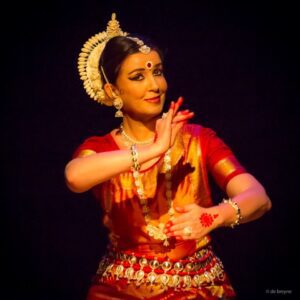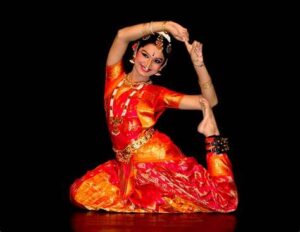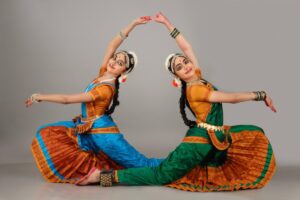Indian Dance
In Indian art and culture Indian Dance It is described in the Natya Shastra of India that when all the gods prayed to Lord Brahma to compose a sadh of Manovino, he created the fifth Veda in the name of Natya Veda by combining some aspects of the four Vedas.

Natya itself is a mixture of dance, drama and music. In this, pathya (words) (gestures) from Rigveda, songs (music) from Samaveda and rasa (bhava) from Atharveda have been mixed, this highlights the divine importance given to dance in Indian cultural tradition. From shiva’s Tandava dance, a symbol of creation and destruction to Parvati’s feminine response, Indian mythology provides examples of dance styles and expressions.
Community dance carvings at Bhimbetka the bronze dance obtained from the excavations of the Harappan civilization reveals dance as a social entertainment discipline The first formal mention of dance is found in the famous India work Natya Shastra.
This work was done between 200 BC and 200 AD in which the most varied and interesting treatises on various aspects of Indian classical are found.
It provides detailed details about techniques, postures, expressions, jewellery, stage and even the audience. Bharat Muni calls dance a complete art, which includes all other forms of art – music, sculpture, poetry, drama.
Forms of Dance
According to Natya Shastra, there are two basic forms of Indian classical dance:
- Lasya: In this, Lalit, Bhava, Rasa and Abhinay are represented
This form of art is called the symbol of special qualities to the woman of dance.
Tandava
This Indian Dance is a form of male orientation and has a strong emphasis on rhythm and tempo.
An acting is divided into three basic elements
Nritta:
Refer to the basic steps of Indian Dance performed rhythmically in which no person or mood is involved.
Drama: Its Asia is from dramatic representations that denote the narrative through continuous presentation.
Dance: dance refers to the rasa and emotion described through dancing.It includes various modes of expression used in dance, including seductive acting and mudras, Nandikeshwar again elaborates the hero heroine sentiment in which the scriptures see the gods as the hero and the export Bhagat as the heroine of the play.
The following nine rasas are expressed through Indian Dance.
Makeup for love, humour for humour and humour for drama, Rodra for anger, Vir for Satrash, Veer for surprise, Amazing for wonder. These moods and expressions are expressed through gestures, hand gestures and body gestures.
There are 108 basic currencies
Indian Dance Forms
In different regions of India, diverse styles of export dictation have developed, each with its own distinct subtlety.
The main rule is that the transfer of knowledge can only be done through the Guru, the Guru India imparts the knowledge of different traditions to the disciple.
According to the Sangeet Natak Akademi, eight classical dance forms are currently in existence in India, including Bharatanatyam, Kuchipudi, Kathakali, Mohiniyattam, Odissi, Manipuri Kathak and Satriya.
Bharatanatyam Indian Dance In Indian art and culture
Bharatanatyam, Indian Dance the oldest classical Indian Dance form, is named after Bharata Muni and Natyam Samvat. In Tamil, Natyam Sambandh means dance. Other scholars attribute the name Bharata to Bhava, Raga and Taal.

In Indian art and culture The origin of this dance is supported by temple dancers or presentation sadir in Tamil Nadu, hence it was also called Dasiattam. After the end of the Devadasi system, this art also became almost endangered. It was a prominent freedom fighter. Krishnan Iyer’s efforts revived this dance form.
This Indian Dance form was performed by solo female dancers. After being revived, this form became increasingly popular among men and artist groups. Another supporter of Bharatanatyam, Rukmani Devi Arundale, is remembered for giving global recognition to this rule. In the early nineteenth century, four continuous teachers of Thanjavur defined the components of the presentation of Bharatanatyam.
Alarippu:This is the invocation part of the demonstration in which the basic continuous postures are honoured and presented with rhythmic syllables, the purpose is to seek God’s blessings
Jatiswaram
It is a Nerata component and is expressionless, it involves various postures and movements.
Shabdam:It is a dramatic element of incorporating the acting in a song with expressive words. It is used in praise of God
Varnam: This is a combination of continuity and emotions, and the most important part of the overall performance is the exporter subtract.
Padma:It refers to proficiency on the acting of a spiritual message by the artist, the music becomes light and becomes constantly emotional
Jawali:This is a short love song poetic presented with relatively triple speed.
Thaillna
This is the culmination stage of the presentation and incorporates a playful rhythm and melee with pure Indian Dance .
Known as Thanjavur-e-chatushaka, these for teachers of Thanjavur are chinnaya, ponnaya, vadivelu and sivanandam. Under his patronage, Bharatanatyam also got fame as Tanjore Natyam, Bharatanatyam is also known as Agni Dance, it expresses fire in the human body. Most of the mudras in Bharatanatyam resemble the swaying flames.
In this mode of routine, equal emphasis is given on both sides of the routine, Tandav and Corpse, mainly the mudras are kept in the center, one of the main mudras is the Katakamukha Hasta in which the symbol of Om is formed by joining three fingers. In the presentation of Bharatanatyam, the knees are mostly bent, and the weight of the body is distributed equally on both the legs.
It is also identified with the Ekachariya Lasyam style in which the same dancer plays a lot of different roles, the lead cast includes Yamini Krishnamurthy, Lakshmi Viswanathan, Padma Subramaniam, Mrinalini Katakamukha, Hasta Sarabai, etc.
Kuchipudi Indian Dance In Indian art and culture
Kuchipudi Inspector Vidya, performed by a group of villages performing actors known as Kush Selva, has been named Veerappan from Kusselvapuri , Kuchelapuram, a village in Namantar. In the 17th century, Siddhendra Yogi formalised and systematised this tradition.
He composed Bhama Kalpanm and many other plays. After the advent of Vasnavavad, this form of Indian Dance became the monopoly of male Brahmins and its performances began to be given in temples, stories from the Bhagavata Purana became the main object of these performances, the dancers came to be known as Bhagavathalus

The Indian Dance form gained special importance under the patronage of the rulers of Vijayanagara and Golconda. It remained confined to villages until it was revived by Balasaraswati and Ragini Devi and remained unpopular until the arrival of the 20th century. In the early 20th century, Laxminarayana Sastri introduced solo singing and female participation in it.
Some of the characteristics of Kuchipudi Indian Dance are as follows:
Most of the Kuchipudi performances are based on the stories of the Bhagavata Purana, but their central motto has been secular, in which Shringar Rasa predominates. Most of the Kuchipudi performances are based on the stories of the Bhagavata Purana, but their central motto has been secular, in which Shringar Rasa predominates.
It is similar to Bharatanatyam but has its own characteristics. Its performance includes the following: Sholaktha pata, often it is the nert which involves the movements of the body.
Kaavutvam :It is the dance part in which extensive acrobatics are honored. It is also performed as a routine. Kuchipudi dance style reveals the earthly elements in the human body.
The Indian Dance style in the Kuchipudi presentation can also combine the role of the singer. Therefore, it becomes a dance drama performance. Both lasya and Tandava elements are important in Kuchipudi Indian Dance form. Apart from group performances, Kuchipudi also has some popular solo elements. Some of them are as follows:
Munduka shabdam :tells the story of a frog.
Tarangam: The dancer performs his duty by placing his feet on the edge of a brass saucer and balancing a water vessel or a set of diyas on his head. Water Picture Dance:
In this performance, the Indian Dance draws a picture on a surface with her toe while dancing. The Kuchipudi performance is a jugalbandi of Carnatic music. Violin and Mridanga are its main tiger instruments. Singing takes place in Telugu language by famous artists Radha Reddy and Raja Reddy, Yamini Krishnamurthy, Indrani Rahman, etc.
Conclusion
In Indian art and culture Indian dance forms each reflect distinct customs, histories, and regional identities, and together they provide a vibrant expression of the nation’s rich cultural legacy.
Indian dance forms, such as Kathak, Kuchipudi, Odissi, Kathakali, Bharatanatyam, and Odissi, have their roots in religious and spiritual traditions and frequently use elaborate movements, facial expressions, and music to tell mythological tales. In Indian art and culture Folk dances that celebrate seasonal festivals, marriages, and communal life, like Bhangra, Garba, and Lavani, showcase the diversity of rural Indian customs.
When combined, these dance styles offer a vibrant fusion of rhythm, emotion, and storytelling that protects India’s artistic heritage. They are still relevant in the modern era because they are constantly evolving and bridging the gap between traditional and modern practices. With their richness and diversity, Indian dance forms are an effective means of preserving and expressing cultural identity.
